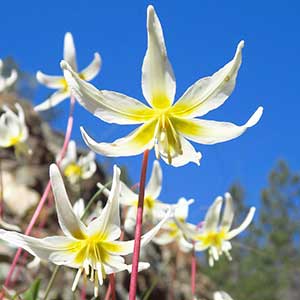Erythronium citrinum
Erythronium mesochoreum
citrus fawn lily, cream fawn lily, lemon color fawn lily, lemon fawn lily, pale fawn-lily
midland fawnlily, prairie trout-lily, white fawnlily
slender, 40–50 mm, sometimes producing sessile offsets.
ovoid to ± globose, 10–25 mm;
stolons absent; flowering plants reproducing vegetatively by droppers or offshoots.
9–15 cm;
blade mottled with irregular streaks of brown or white, lanceolate to narrowly ovate, margins ± wavy.
5–14 cm;
blade green, usually not mottled, elliptic-lanceolate to ovate-lanceolate, conduplicate, glaucous, base and margins sometimes purple-brown, margins even.
12–35 cm.
5–15 cm.
1–3-flowered.
1-flowered.
tepals ± white, often pinkish, usually pale yellow at base, lanceolate to narrowly elliptic, 25–45 mm, inner with or without small auricles at base;
stamens 11–17 mm;
filaments linear, white or pinkish, slender, less than 0.8 mm wide;
anthers white, cream, pink, reddish, or brownish red;
style straight, white or pink, 6–10 mm;
stigma unlobed or with lobes shorter than 1 mm.
tepals spreading at anthesis, white, tinged pink, blue, or lavender abaxially, with yellow adaxial spot at base, lanceolate, 15–30 mm, auricles absent;
stamens 8–15 mm;
filaments yellow, lanceolate;
anthers yellow;
pollen yellow;
style white, 7–10 mm;
stigma lobes recurving, 1–1.5 mm.
obovoid, 2–5 cm.
resting on ground at maturity due to reclining peduncle, obovoid, 10–15 mm, apex rounded to faintly apiculate or umbilicate.
= 24.
= 22.
Erythronium citrinum
Erythronium mesochoreum
Plants lacking auricles on inner tepals are sometimes segregated as Erythronium howellii, Howell’s fawn-lily, but they do not appear to differ from typical E. citrinum in any other characters. Erythronium citrinum intergrades with E. californicum and E. hendersonii, occasional populations or individuals displaying intermediate or recombined characteristics. Such plants from the upper Scott River drainage in Trinity County, California, which may be the result of introgression with E. hendersonii, have been recognized as variety roderickii.
(Discussion copyrighted by Flora of North America; reprinted with permission.)
Because stolons are absent in Erythronium mesochoreum, most plants in a population produce flowers; nonflowering plants may sometimes appear after flowering plants have flowered. This species is well adapted to prairie fires. The seeds have elaiosomes, and ants may act as dispersal agents (Great Plains Flora Association 1986). C. C. Deam et al. (1941) reported E. mesochoreum from Indiana, but an examination of the specimens cited, now at IND, showed that these are E. albidum. E. L. Braun (1967) reported that many populations of E. albidum in southwestern Ohio indicate introgression with “the Ozarkean var. mesochoreum���.” However, personal observation by K. R. Robertson of several Ohio populations in flower confirmed that these plants are true E. albidum, although they occur in prairies and have more or less conduplicate leaves.
(Discussion copyrighted by Flora of North America; reprinted with permission.)


